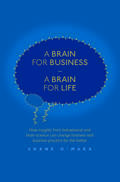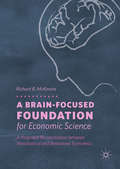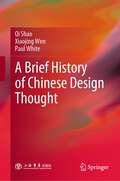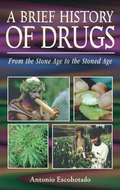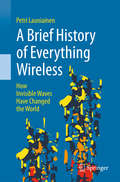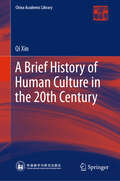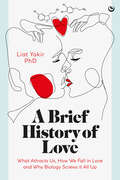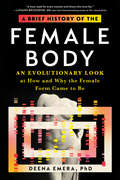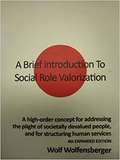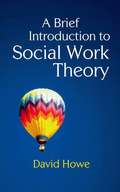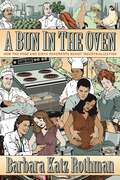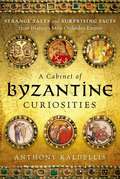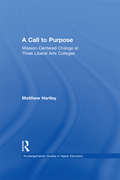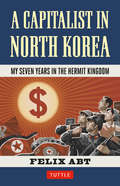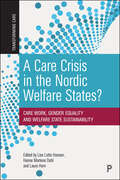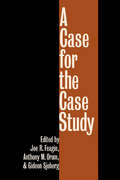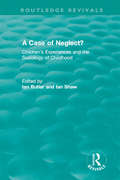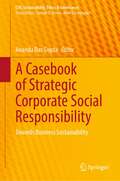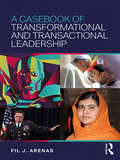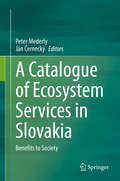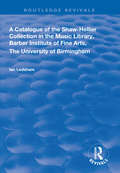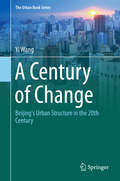- Table View
- List View
A Brain for Business – A Brain for Life
by Shane O'MaraBehaviour change is hard, but O’Mara shows that by adopting strategies that are well-founded in the science of brain and behaviour individuals and organisations can adapt to the demands of the modern world.The brain matters in business. The problem is that our brains have many biases, heuristics and predilections that can distort behaviour and decision making. The good news is that we know more about how these work than ever before. O’Mara’s starting point is that, as our behaviour arises from the structure and function of our brains, careful examination of a series of brain–based (‘neurocognitive’) analyses of common aspects of human behaviour relevant to business and management practice reveals lessons that can be used at work. He begins by looking at neuroplasticity and how it is enables a shift from a restrictive ‘fixed mindset’ to an enabling ‘growth mindset’. He shows how this changing mindset approach – where the focus is on task and improvements based on effort – is scalable within organisations. Next, as the brain is a living organ like the heart and lungs, O’Mara shows how to keep it physically in the best possible shape before examining how we exercise control over our behaviour, build resilience and create positive brain states. He also considers the implications for business of our brains wiring for status and illustrates how research shows that it is possible to de-bias assumptions about gender and race – and the impact that this has on performance.
A Brain-Focused Foundation for Economic Science: A Proposed Reconciliation between Neoclassical and Behavioral Economics
by Richard B. McKenzieThis book argues that Lionel Robbins’s construction of the economics field’s organizing cornerstone, scarcity—and all that has been derived from it from economists in Robbins’s time to today—no longer can generate general consent among economists. Since Robbins’ Essay, economists have learned more than Robbins and his cohorts could have imagined about human decision making and about the human brain that is the lynchpin of human decision making. This book argues however that behavioral economists and neuroeconomists, in pointing to numerous ways people fall short of perfectly rational decisions (anomalies, biases, and downright errors), have saved conventional economics from such self-contradictions in what could be viewed as a wayward approach. This book posits that the human brain is the ultimate scarce resource, and that a focus on the brain can bring a new foundation for economics and can save the discipline from hostile criticisms from a variety of non-economists (many psychologists).
A Brief History of Chinese Design Thought
by Paul White Qi Shao Xiaojing WenThis book introduces readers to the history of design thinking in pre-modern China. The content is structured according to successive dynasties, covering the seven major periods of the pre-Qin, Qin and Han, Wei and Jin, Sui and Tang, Song and Yuan, Ming, and Qing dynasties. Each chapter introduces the most representative individuals of the period and discusses their work and ideas in order to reveal the national and cultural features of the respective periods. A distinctive feature of cultural identity running through the long course of China’s historical development is the argument that actions are determined by ideas: Such a view can be found in long-standing thinking on art, design, and creativity. The book demonstrates that conscious design is the vital link between the ideas that constitute human cultures and the physical objects that make up their resulting material cultures. It is the attribute of design that defines what it is to be human and also produces the physical evidence of the evolution of Chinese civilization. The book reveals the integrated characteristics of Chinese culture and art and shows how both changing and recurring ideologies have influenced Chinese design practice since the ancient Shang and Zhou dynasties and how these forces have shaped the spirit and materiality of Chinese civilization. Design is the cornerstone that has made China one of the major contributors to human civilization throughout the thousands of years of its history.Given its focus, the book largely appeals to two main audiences: an academic readership of students and researchers interested in cultural studies and, a more general one, consisting of those interested in international comparisons and wishing to learn more about Chinese history, society, and culture. In order to appeal to both, the book is written in a clear and accessible language.
A Brief History of Drugs: From the Stone Age to the Stoned Age
by Antonio EscohotadoThis fascinating book examines the instrumental role drugs have played in our cultural, social, and spiritual development from antiquity to the present.
A Brief History of Everything Wireless: How Invisible Waves Have Changed the World
by Petri LauniainenSince the discovery of electromagnetic waves less than 150 years ago, the application of wireless communications technology has not only revolutionized our daily lives, but also fundamentally changed the course of world history.A Brief History of Everything Wireless charts the fascinating story of wireless communications. The book leads the reader on an intriguing journey of personal triumphs and stinging defeats, relating the prominent events, individuals and companies involved in each progressive leap in technology, with a particular focus on the phenomenal impact of each new invention on society. Beginning at the early days of spark-gap transmitters, this tale touches on the emergence of radio and television broadcasting, as well as radio navigation and radar, before moving on to the rise of satellite, near-field and light-based communications. Finally, the development of wireless home networks and the explosive growth of modern cellular technologies are revealed, complete with a captivating account of their corresponding company histories and behind-the-scenes battles over standards.For those wishing to peek behind the magic curtain of friendly user interfaces and clever engineering, and delve further into various processes underlying the ubiquitous technology we depend upon yet take for granted, the book also contains special “TechTalk” chapters that explain the theoretical basics in an intuitive way.
A Brief History of Human Culture in the 20th Century (China Academic Library)
by Qi XinThis book examines the cultural concepts that guided the development of the “age of mankind”— the changes that took place in historical, philosophical, scientific, religious, literary, and artistic thought in the 20th century. It discusses a broad range of major topics, including the spread of commercial capitalism; socialist revolutions; the two world wars; anti-colonialist national liberation movements; scientific progress; the clashes and fusion of Eastern and Western cultures; globalization; women’s rights movements; mass media and entertainment; the age of information and the digital society. The combination of cultural phenomena and theoretical descriptions ensures a unity of culture, history and logic. Lastly, the book explores the enormous changes in lifestyles and the virtualized future, revealing cultural characteristics and discussing 21st -century trends in the context of information technology, globalization and the digital era.
A Brief History of Love: What Attracts Us, How We Fall in Love and Why Biology Screws it All Up
by Liat YakirIs love about chemistry or do biology, evolution and psychology all have a part to play?Love is one of the most complex and confusing emotions in the human experience. It consumes so much of our lives and yet we don&’t truly understand it – what it is on a biological, chemical and evolutionary level. This book takes you on a fascinating journey to explore the science of love, looking closely at the interplay between genes, hormones, emotions and relationships.Discover everything you need to know about why you are attracted to certain people, the brain&’s role in your emotions, how to pick &“the one&” and how to preserve that love over time. Learn how to have better, healthier and more loving relationships by understanding the inner workings of love in your body.
A Brief History of Schooling in the United States: From Pre-Colonial Times to the Present (The Cultural and Social Foundations of Education)
by Edward JanakThis book presents a sweeping overview of the historical and philosophical foundations of schooling in the United States. Beginning with education among the indigenous peoples of the Americas and going on to explore European models of schooling brought into the United States by European colonists, the author carefully traces the arc of educational reform through major episodes of the nation’s history. In doing so, Janak establishes links between schools, politics, and society to help readers understand the forces impacting educational policy from its earliest conception to the modern day. Chapters focus on the philosophical, political, and social concepts that shaped schooling of dominant and subcultures in the United States in each period. Far from being merely concerned with theoretical foundations, each chapter also presents a snapshot of the “nuts and bolts” of schooling during each period, examining issues such as pedagogical devices, physical plants, curricular decisions, and funding patterns.
A Brief History of the Female Body: An Evolutionary Look at How and Why the Female Form Came to Be
by Dr. Deena EmeraFrom breasts and orgasms to periods, pregnancies, and menopause—A Brief History of the Female Body is a fascinating science book explaining the mysteries of the female body through an evolutionary lens.Let's face it: The female body is an enigma. For teenagers first experiencing their periods, the monthly arrival of mood swings and cramps can be agonizing and inconvenient. With pregnancy—perhaps the most miraculous of bodily events—comes countless potential complications, including high blood pressure, diabetes, premature birth, and postpartum depression. And menopause is equally mystifying. Why do females lose their fertility over time and experience the notorious side effects—like hot flashes, weight gain, and hair loss—while males maintain their fertility forever?Evolutionary geneticist and educator Dr. Deena Emera has spent much of her career studying the evolution of female reproduction. A Brief History of the Female Body draws on her vast expertise as a biologist, her experience as a mother of four children, and her love of teaching to look far into our evolutionary past, illuminating how and, more importantly, why the female form has transformed over millions of years and its effects on women's health.
A Brief Introduction To Social Role Valorization
by Wolf WolfensbergerSRV Theory opens up to students a different way of understanding the world in general, and the experiences of human suffering and marginalization in particular.
A Brief Introduction to Social Work Theory
by David HoweThis crisp text, by one of social works most highly regarded commentators, offers the perfect entry point into the complex world of social work theory. Written in a clear conversational style and organized into short, clearly labelled chapters, students and practitioners will find this an invaluable point of refreshment and reference.
A Buddhist Theory of Killing: A Philosophical Exposition
by Martin KovanThis book provides a philosophical account of the normative status of killing in Buddhism. Its argument theorises on relevant Buddhist philosophical grounds the metaphysical, phenomenological and ethical dimensions of the distinct intentional classes of killing, in dialogue with some elements of Western philosophical thought. In doing so, it aims to provide a descriptive account of the causal bases of intentional killing, a global justification and elucidation of Buddhist norms regarding killing, and an intellectual response to and critique of alternative conceptions of such norms presented in recent Buddhist Studies scholarship. It examines early and classical Buddhist accounts of the evaluation of killing, systematising and rationally assessing these claims on both Buddhist and contemporary Western philosophical grounds. The book provides the conceptual foundation for the discussion, engaging original reconstructive philosophical analyses to both bolster and critique classical Indian Buddhist positions on killing and its evaluation, as well as contemporary Buddhist Studies scholarship concerning these positions. In doing so, it provides a systematic and critical account of the subject hitherto absent in the field. Engaging Buddhist philosophy from scholastic dogmatics to epistemology and metaphysics, this book is relevant to advanced students and scholars in philosophy and religious studies.
A Bun in the Oven: How the Food and Birth Movements Resist Industrialization
by Barbara Katz RothmanThere are people dedicated to improving the way we eat, and people dedicated to improving the way we give birth. A Bun in the Oven is the first comparison of these two social movements. The food movement has seemingly exploded, but little has changed in the diet of most Americans. And while there’s talk of improving the childbirth experience, most births happen in large hospitals, about a third result in C-sections, and the US does not fare well in infant or maternal outcomes. In A Bun in the Oven Barbara Katz Rothman traces the food and the birth movements through three major phases over the course of the 20th century in the United States: from the early 20th century era of scientific management; through to the consumerism of Post World War II with its ‘turn to the French’ in making things gracious; to the late 20th century counter-culture midwives and counter-cuisine cooks. The book explores the tension throughout all of these eras between the industrial demands of mass-management and profit-making, and the social movements—composed largely of women coming together from very different feminist sensibilities—which are working to expose the harmful consequences of industrialization, and make birth and food both meaningful and healthy. Katz Rothman, an internationally recognized sociologist named ‘midwife to the movement’ by the Midwives Alliance of North America, turns her attention to the lessons to be learned from the food movement, and the parallel forces shaping both of these consumer-based social movements. In both movements, issues of the natural, the authentic, and the importance of ‘meaningful’ and ‘personal’ experiences get balanced against discussions of what is sensible, convenient and safe. And both movements operate in a context of commercial and corporate interests, which places profit and efficiency above individual experiences and outcomes. A Bun in the Oven brings new insight into the relationship between our most intimate, personal experiences, the industries that control them, and the social movements that resist the industrialization of life and seek to birth change.
A Cabinet of Byzantine Curiosities: Strange Tales and Surprising Facts from History's Most Orthodox Empire
by Anthony KaldellisWeird, decadent, degenerate, racially mixed, superstitious, theocratic, effeminate, and even hyper-literate, Byzantium has long been regarded by many as one big curiosity. According to Voltaire, it represented "a worthless collection of miracles, a disgrace for the human mind"; for Hegel, it was "a disgusting picture of imbecility." A Cabinet of Byzantine Curiosities will churn up these old prejudices, while also stimulating a deeper interest among readers in one of history's most interesting civilizations. Many of the zanier tales and trivia that are collected here revolve around the political and religious life of Byzantium. Thus, stories of saints, relics, and their miracles-from the hilarious to the revolting-abound. Byzantine bureaucracy (whence the adjective "Byzantine"), court scandals, and elaborate penal code are world famous. And what would Byzantium be without its eunuchs, whose ambiguous gender produced odd and risible outcomes in different contexts? The book also contains sections on daily life that are equally eye-opening, including food (from aphrodisiacs to fermented fish sauce), games such as polo and acrobatics, and obnoxious views of foreigners and others (e.g., Germans, Catholics, Arabs, dwarves). But lest we overlook Byzantium's more honorable contributions to civilization, also included are some of the marvels of Byzantine science and technology, from the military (flamethrowers and hand grenades) to the theatrical ("elevator" thrones, roaring mechanical lions) and medical (catheters and cures, some bizarre). This vast assortment of historical anomaly and absurdity sheds vital light on one of history's most obscure and orthodox empires.
A Call to Purpose: Mission-Centered Change at Three Liberal Arts Colleges (RoutledgeFalmer Studies in Higher Education)
by Matthew HartleyA decade ago, the majority of liberal arts colleges, suffering from a decline in resources, drifted from their traditional missions. This study looks at three insitutions and suggests that a clear mission is more than a common goal.
A Capitalist In North Korea
by Felix AbtBusiness in North Korea: a paradoxical and fascinating situation is interpreted by a true insider. In 2002, the Swiss power company ABB appointed Felix Abt its country director for North Korea. The Swiss Entrepreneur lived and worked in North Korea for seven years, one of the few foreign businessmen there. After the experience, Abt felt compelled to write A Capitalist in North Korea to describe the multifaceted society he encountered. North Korea, at the time, was heavily sanctioned by the UN, which made it extremely difficult to do business. Yet, he discovered that it was a place where plastic surgery and South Korean TV dramas were wildly popular and where he rarely needed to walk more than a block to grab a quick hamburger. He was closely monitored, and once faced accusations of spying, yet he learned that young North Koreans are hopeful-signing up for business courses in anticipation of a brighter, more open, future. In A Capitalist in North Korea, Abt shares these and many other unusual facts and insights about one of the world's most secretive nations.
A Care Crisis in the Nordic Welfare States?: Care Work, Gender Equality and Welfare State Sustainability (Transforming Care)
by Lise Lotte Hansen, Hanne Marlene Dahl and Laura HornIn this insightful collection, academic experts consider the impact of neoliberal policies and ideology on the status of care work in Nordic countries. With new research perspectives and empirical analyses, it assesses challenges for care work including technologies, management and policy-making. Arguing that there is a care crisis even in the supposedly feminist Nordic ‘nirvana’, this book explores understandings of the care crisis, the serious consequences for gender equality and the hitherto neglected effects on the long-term sustainability of the Nordic welfare states. This astute take on the Nordic welfare model provides insights into what the Nordic experience can tell us about wider international issues in care.
A Case Study for Computer Ethics in Context: The Scandal in Academia
by Michael James Heron Pauline Helen BelfordAimed at addressing the difficulties associated with teaching often abstract elements of technical ethics, this book is an extended fictional case study into the complexities of technology and social structures in complex organizations. Within this case study, an accidental discovery reveals that the algorithms of Professor John Blackbriar are not quite what they were purported to be. Over the course of 14 newspaper articles, a nebula of professional malpractice and ethical compromise is revealed, ultimately destroying the career of a prominent, successful academic.The case study touches on many topics relevant to ethics and professional conduct in computer science, and on the social structures within which computer science functions. Themes range from the growing influence of generative AI to the difficulties in explaining complex technical processes to a general audience, also touching on the environmental consequences of blockchain technology and the disproportionate gender impacts of Coronavirus. Each new revelation in the case study unveils further layers of complexity and compromise, leading to new technical and social issues that need to be addressed.Directly aimed at making ethics in the digital age accessible through the use of real-world examples, this book appeals to computer science students at all levels of the educational system, as well as making an excellent accompaniment to lecturers and course convenors alike.
A Case for the Case Study
by Joe R. Feagin, Anthony M. Orum and Gideon SjobergSince the end of World War II, social science research has become increasingly quantitative in nature. A Case for the Case Study provides a rationale for an alternative to quantitative research: the close investigation of single instances of social phenomena.The first section of the book contains an overview of the central methodological issues involved in the use of the case study method. Then, well-known scholars describe how they undertook case study research in order to understand changes in church involvement, city life, gender roles, white-collar crimes, family structure, homelessness, and other types of social experience. Each contributor confronts several key questions: What does the case study tell us that other approaches cannot? To what extent can one generalize from the study of a single case or of a highly limited set of cases? Does case study work provide the basis for postulating broad principles of social structure and behavior? The answers vary, but the consensus is that the opportunity to examine certain kinds of social phenomena in depth enables social scientists to advance greatly our empirical understanding of social life.The contributors are Leon Anderson, Howard M. Bahr, Theodore Caplow, Joe R. Feagin, Gilbert Geis, Gerald Handel, Anthonly M. Orum, Andree F. Sjoberg, Gideon Sjoberg, David A. Snow, Ted R. Vaughan, R. Stephen Warner, Christine L. Williams, and Norma Williams.
A Case of Neglect?: Children's Experiences and the Sociology of Childhood (Routledge Revivals)
by Ian Butler and Ian ShawPublished in 1996, this book advocates and persuasively exemplifies a qualitative sociology of childhood, spoken repeatedly through children’s voices. After a long period of dormancy, interest in the sociology of childhood became a focus of attention and scholarly interest. Developments in practice by professionals working and learning in the fields of welfare, education, and youth and community studies have been paralleled by the emergence of specialist courses within sociology degrees. Yet the challenges raised by the sociology of childhood remain marginalised within the social sciences more generally. A Case of Neglect? provides an accessible reader and review of the field. Heard wherever possible through children’s and young people’s voices, it provides a penetrating insight into their understandings and experiences of their own and adults’ worlds. It also provides a readable and absorbing review of qualitative applications in the sociology of childhood, and a counter to the common reliance on evidence derived from quantitative approaches. The fieldwork applications range across the often hidden worlds of children’s and young people’s involvement in prostitution, their experience of abuse, black children’s experiences of social services, children’s school cultures, naturist children and childlessness. Always arresting and sometimes poignant, A Case of Neglect? works towards a sociology which is both of and for childhood. This book was originally published as part of the Cardiff Papers in Qualitative Research series edited by Paul Atkinson, Sara Delamont and Amanda Coffey. The series publishes original sociological research that reflects the tradition of qualitative and ethnographic inquiry developed at Cardiff. The series includes monographs reporting on empirical research, edited collections focussing on particular themes, and texts discussing methodological developments and issues.
A Casebook of Strategic Corporate Social Responsibility: Towards Business Sustainability (CSR, Sustainability, Ethics & Governance)
by Ananda Das GuptaThis casebook argues that corporate sustainability agendas should look beyond stakeholder demands and desires, towards strategic opportunities to achieve social and commercial benefits simultaneously. It encourages shifting focus from a strategic approach to a sustainable business practice. As the cases in the book highlight, it is in every company’s best interest to identify a manageable number of sustainability initiatives whose shared benefits—for society at large and the company—are significant and also substantially help the company strategically position itself in the competitive marketplace. Strategic sustainable business practices can lead to shared value creation, strengthening the company’s competitiveness and establishing a symbiotic relationship. Companies can achieve solid profits by doing good things for the environment; it is a “win-win” for society and for business. This casebook provides examples of multi-stakeholder partnerships that aim to create sustainable enterprises. Ideal for teaching purposes, after a brief introduction to the case method, the cases are presented with no comments or criticisms.
A Casebook of Transformational and Transactional Leadership
by Fil J. ArenasFeaturing more than twenty-five case studies of leaders throughout history, A Casebook of Transformational and Transactional Leadership supplements existing texts on transformational leadership and the full range model to promote higher levels of understanding of transformational and transactional leadership behaviors. Beginning with an overview of transformational and transactional behavior components, Arenas describes the original tenets of leadership researchers, demonstrating how practicing the principles of full range leadership can aid those who guide or manage others. The subsequent chapters examine influential figures from various organizational environments to provide readers with examples that connect with core full range leadership concepts. Finally, each chapter ends with a discussion question, helping to engage students with the material and encouraging further reflection and study. A Casebook of Transformational and Transactional Leadership is essential reading for both graduate and undergraduate students of leadership development, as well as military and non-military professionals in leadership, leadership development, business and management, and education.
A Catalogue of Ecosystem Services in Slovakia: Benefits to Society
by Peter Mederly Ján ČerneckýThis book provides the first comprehensive assessment of ecosystem services (ES) for the territory of the Slovak Republic. Although the ES approach is widely used for the evaluation of the benefits of natural capital and biodiversity for people, this book has a unique character. It provides an assessment of 18 individual ES, which are divided into three main groups - provisioning, regulatory/supporting and cultural ES. For each of ES, a brief theoretical and methodological overview is given, followed by spatial assessment based on own original methodology and dataset of 40 map layers. Besides, an evaluation of main ES groups and overall ES assessment is realized. This book emphasizes the key role of nature protection areas, large areas of forest ecosystems and mountain and sub-mountain areas, for the preservation of the various functions of the healthy landscape and ecosystems. The complexity of the book guarantees its usefulness - not only as the knowledge base for the territory of Slovakia but also as the methodological tool for worldwide researchers.
A Catalogue of the Shaw-Hellier Collection (Routledge Revivals)
by Ian LedshamIn this compilation, first published in 1999, Ian Ledsham compiles an extensive catalogue of the Shaw-Hellier Collection, complete with diagrams regarding how we use text.
A Century of Change: Beijing's Urban Structure in the 20th Century (The Urban Book Series)
by Yi WangThis book provides a comprehensive overview of the evolution of Beijing's urban structure in the 20th century, analyzing essential social and economic changes in the housing sector. Focusing on the urban changes that took place under the market economy after 1978 and beyond, the book addresses the demolition of courtyard houses in Beijing's old city, the relocation of low-income families from the old city, the government's role regarding housing in the city, and residential segregation in Beijing. Expanding on the author's PhD thesis at the University of Cambridge, it is illustrated with a wealth of historic photos and maps of Beijing. Presenting relevant descriptions, extensive literature and case studies, the book offers a valuable resource for students and scholars of architecture, urban studies and Chinese studies. First published in 2013 by Pace in Hong Kong, it has since been added to the libraries of many distinguished universities, including Harvard, MIT, Princeton, Columbia, Yale, Stanford, Cornell, U Penn, NYU, UC Berkeley, Hong Kong University, UBC in Canada and the University of Witwatersrand in South Africa.
